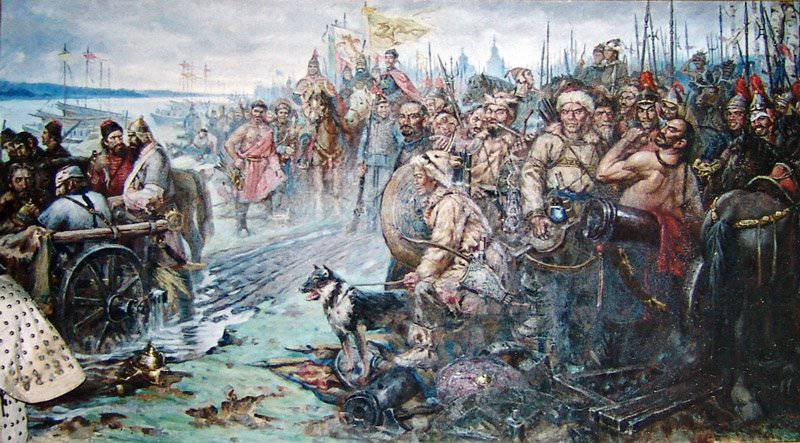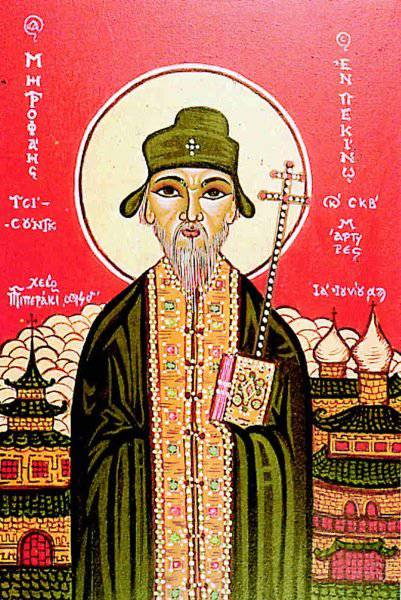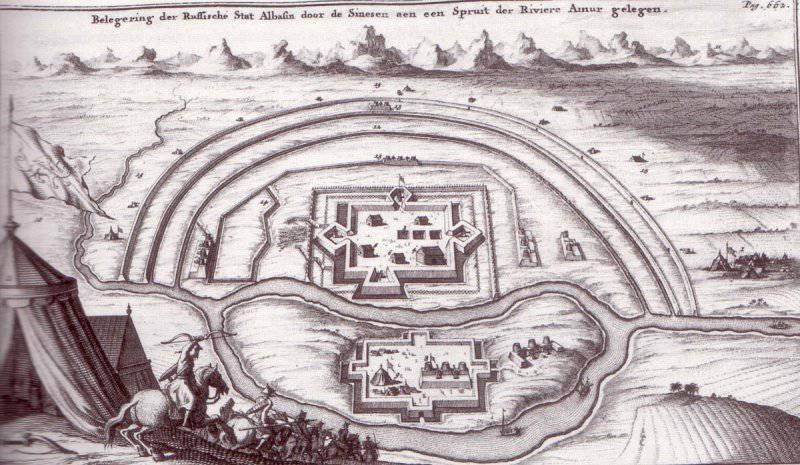Cossacks in the service of the Chinese emperor

Scorched earth
One event that happened two decades before the Russians arrived in Beijing can explain the reasons why the Cossacks immigrated to the East.
In 1665, a group of Cossacks, headed by Nikifor Chernigovsky, came to the Far Eastern Amur River, uncharted by the Russian people to this day. They were insurgents who had raised a rebellion in Ilimsky prison, while killing Lawrence Obukhov, the governor, who for a long time brutally oppressed them.
The fugitives founded a settlement on the Amur - Albazin, in which they wanted to live freely. Their hopes were destined to come true. Officially, Albazino was not recognized by the authorities of the Russian Empire, but the Cossacks managed to improve relations with local residents. And despite the fact that they were considered criminals, the collected tax was regularly sent to Moscow, using the Nerchinsk burg. As a result, Tsar Alexei Mikhailovich forgave the rebels, even those who were sentenced to death for the murder of the governor. From 1669, a clerk sent from Nerchinsk began to manage the Albazinsky jail, and the settlement was officially recognized as part of Russia.
However, the Cossacks had a very strained relationship with their Manchu neighbors. In the summer of 1670, Ostrozhek was besieged by numerous equestrian Manchu troops.
However, the attack was able to repel, but the attacks of the warriors of the Middle Kingdom since then have become commonplace for the Cossacks. Manchu’s dislike of Russians has a fairly simple explanation. The reason was Erofei Khabarov, who walked around this land with fire and sword, plundering the Daurian cities. Not for nothing did Albazin get its name, it stood on the site of the city burned to the ground, under the control of the local prince Albazin. Many of the daurs went to China to escape from the Russian “pioneer”, while retaining in their souls the desire to avenge and return their lands. The rulers of the Tsinn Empire also had their plans for Dahurian territory.
Albazin Battle
12 June 1685 of the year at Albazin was a Manchu army of five thousand men. It consisted of a thousand equestrian, 2800 infantry and 1200 workers, who were called to erect siege installations. Besides bows and various cold weapons, they brought 45 large and small guns, as well as about a hundred squeals from the Russians in battles. The besieged were able to counter the invasion of the entire 450 people, mainly servicemen, industrial and commercial people and peasants. They were armed with only three hundred pishchaly and three guns. Despite the numerical superiority, the Cossacks were able to hold out on the defense for ten days. 16 June Manchus tried to take the fortress by storm, but despite the fact that the towers were destroyed by cannon fire, the barn was burned, the church, the besieged had gunpowder and lead, the Cossacks still held out. The Manchurian commander Lantany decided to lay a brush over the walls and set fire to it. Only after that did Tolbuzin agree to negotiate with the Manchus. The condition for the surrender was to allow the Russian survivors to go with their belongings to Nerchinsk. However, after the Cossacks ceased to defend themselves, the Chinese took all their property and took them captive to women and children. However, Lantan was admired by the fearlessness with which the Cossacks defended and invited them to go to the service of the emperor. In order not to lose their families, the consent was given by 45 people. The rest had to walk "naked, barefoot and hungry" to get to Nerchinsk.
But story The assault did not end there. After the expiration of five days from the arrival of the refugees, the voivode Nerchinsk sent a reconnaissance detachment in the number of 70 Cossacks to the battle sites. Those managed to find out that the Manchus left the ruined fortress. It was decided to send a new army there, and to erect another prison in the place of the destroyed one. By June 1688, the construction was completed, but in July it was again besieged by the Manchus. However, despite the numerical superiority, this time the Manchus could not take it. The siege lasted several months. In early December, there were only 150 people in Albazin, of whom only 45 were capable of holding weapons. However, the Manchus lost a significant part of their army. Various diseases raged in the camp, and they suffered from hunger, as the Chinese ships with provisions could not come because of the ice that bound the river. Even after receiving the order to lift the siege of 30 in November, due to the arrival in Moscow of Ambassador Fyodor Golovin, the Manchus could not leave their positions until spring, having lost many more soldiers.
In May, the 1687 of the year in the besieged fortress remained only 67 people, but still the Cossacks did not surrender. Moreover, in order to mislead the enemy about their situation, Beyton refused to help the Manchurian healers, and even sent them wheat cake for Easter, despite the famine that prevailed in the fortress. This courage played a huge role in further negotiations on the definition of new Far Eastern borders, since, for example, Albazin, the Zinn Empire understood that the Russians would not leave without a fight.
 Yellow Banner Company
Yellow Banner CompanyAll this time, "voluntarily transferred" to the service of the emperor, the Cossacks hoped for liberation. But after the signing of the Treaty of Nerchinsk, the last hope for a homecoming was lost. The document stated the clause that "the fugitives, who, before this peaceful decree, were both from the side of the royal majesty and the highness of Bugdykhanov, and those gatekeepers can be on both sides without meaning." Those who still crossed the border, should be returned back to border governors. Thus, Albazinians ended up in Beijing. The emperor treated the Cossacks quite favorably, providing them with a piece of land in the Inner City for life. The Russians were able to preserve their Orthodox faith. They were even allowed to use the Buddhist temple for worship, later turned by priest Maxim Leontiev into the chapel of St. Nicholas. The Cossacks were ranked as a military estate, identifying the Manchu Guard as the yellow banner, calling them Oros Niru (“Russian Company”).
In Russia, meanwhile, there was a coup that brought Peter I to power. Upon learning of the Russian settlement in China, Peter immediately realized that this offered great promise in trade and politics. 18 June 1700, he issued a decree on the spread of Orthodoxy in Chinese lands. True, the king’s will could be fulfilled only after 16 years, but since the 1716 of the Year, spiritual Russian missions regularly went to Beijing.
Since then, more than three centuries have passed. About 250 people who currently belong to the direct descendants of the Albazins live in China at the moment. Naturally, thanks to mixed marriages, they almost completely lost the features of the Slavs, and the last names also changed: the former Yakovlevs turned into Yao, the Dubinins - Du, the Romanovs - Lo. However, the Orthodox faith remained in the majority of the Cossacks. And they still have the memory of events in the fortress of Albazin, thanks to which they ended up in China, the memory of the heroism of their ancestors.

Information